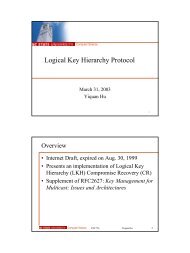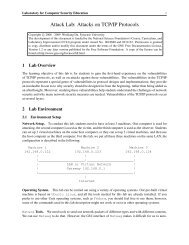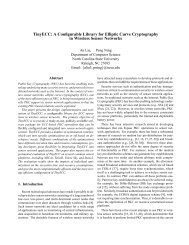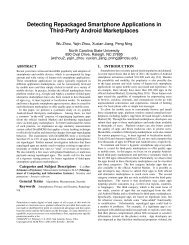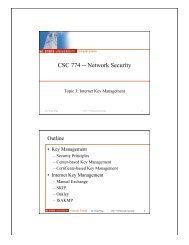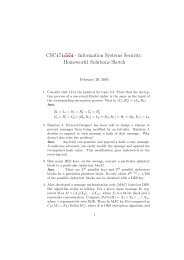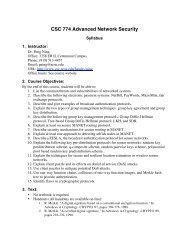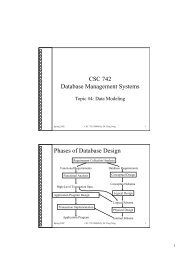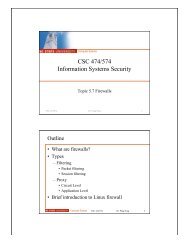Correlating Alerts Using Prerequisites of Intrusions - Dr. Peng Ning ...
Correlating Alerts Using Prerequisites of Intrusions - Dr. Peng Ning ...
Correlating Alerts Using Prerequisites of Intrusions - Dr. Peng Ning ...
Create successful ePaper yourself
Turn your PDF publications into a flip-book with our unique Google optimized e-Paper software.
and development <strong>of</strong> the systems. As a result, the detection and response based techniques (i.e., intrusion<br />
detection and response systems) are used as a second line <strong>of</strong> defense along with the prevention-based ones.<br />
Intrusion detection techniques can be roughly classified as anomaly detection and misuse detection.<br />
Anomaly detection (e.g., NIDES/STAT [10]) is based on the normal behavior <strong>of</strong> a subject (e.g., a user<br />
or a system); any action that significantly deviates from the normal behavior is considered intrusive. Misuse<br />
detection (e.g., NetSTAT [21]) detects intrusions based on the characteristics <strong>of</strong> known attacks or system<br />
vulnerabilities; any action that conforms to the pattern <strong>of</strong> a known attack or vulnerability is considered<br />
intrusive.<br />
Intrusion detection techniques are still far from perfect; current intrusion detection systems (IDSs) cannot<br />
fully detect novel attacks or variations <strong>of</strong> known attacks without generating a large amount <strong>of</strong> false alerts<br />
(i.e., high false alert rate and low detection rate). In addition, all the current IDSs focus on low-level attacks<br />
or anomalies; none <strong>of</strong> them can capture the logical steps or strategies behind these attacks. Consequently,<br />
the IDSs usually generate a large amount <strong>of</strong> alerts, and the alerts are raised independently though there may<br />
be logical connections between them. In situations where there are intensive intrusive actions, not only will<br />
actual alerts be mixed with false alerts, but the amount <strong>of</strong> alerts will also become unmanageable. As a result,<br />
it is difficult for human users or intrusion response systems to understand the intrusion behind the alerts and<br />
take appropriate actions.<br />
An important fact has been ignored by most <strong>of</strong> the current intrusion detection techniques. That is, most<br />
intrusions are not isolated, but related as different stages <strong>of</strong> series <strong>of</strong> attacks, with the early stages preparing<br />
for the later ones. For example, hackers need to understand what vulnerable services a host is running<br />
before they can take advantage <strong>of</strong> these services. Thus, they typically scan for vulnerable services before<br />
they break into the system. As another example, in the Distributed Denial <strong>of</strong> Service (DDOS) attacks, the<br />
attacker has to install the DDOS daemon programs in vulnerable hosts before he can instruct the daemons<br />
to launch an attack against another system. Therefore, in a series <strong>of</strong> attacks, one or more previous attacks<br />
usually prepare for the following attacks, and the success <strong>of</strong> the previous steps affects the success <strong>of</strong> the<br />
following ones. In other words, there are <strong>of</strong>ten logical steps or strategies behind series <strong>of</strong> attacks.<br />
Based on this observation, we propose to correlate alerts using prerequisites <strong>of</strong> intrusions to address<br />
the aforementioned problems. Intuitively, the prerequisite <strong>of</strong> an intrusion is the necessary condition for<br />
the intrusion to be successful. For example, the existence <strong>of</strong> a vulnerable service is the prerequisite <strong>of</strong><br />
a remote buffer overflow attack against the service. We assume that the attackers need to launch some<br />
attacks to prepare for the prerequisites <strong>of</strong> some later attacks. For example, they may perform a UDP port<br />
scan to discover the vulnerable services to be attacked. Our basic idea is to identify the prerequisites (e.g.,<br />
existence <strong>of</strong> vulnerable services) and the consequences (e.g., discovery <strong>of</strong> vulnerable services) <strong>of</strong> each type<br />
<strong>of</strong> attacks and correlate the attacks (alerts) by matching the consequences <strong>of</strong> some previous attacks and the<br />
prerequisites <strong>of</strong> some later ones. (Some types <strong>of</strong> attacks are variations <strong>of</strong> each other, and thus should be<br />
treated as the same type.) For example, if we find a UDP port scan followed by a buffer overflow attack<br />
against one <strong>of</strong> the scanned ports, we can correlate them to be parts <strong>of</strong> the same series <strong>of</strong> attacks.<br />
Our proposed approach has several advantages. First, by providing a high-level representation <strong>of</strong> the<br />
correlated alerts (see section 3.4), our approach reveals the structure <strong>of</strong> a series <strong>of</strong> attacks as well as the<br />
strategy behind them. Second, our approach can potentially reduce the impact caused by false alerts. False<br />
alerts, which do not correspond to any real attacks, tend to be more random than the actual attacks, and<br />
are less likely to be correlated to other alerts. Therefore, we can focus on the potentially actual attacks<br />
by picking out the correlated alerts. Finally, our approach can be potentially extended to predict attacks in<br />
progress. By pr<strong>of</strong>iling the past correlated alerts, we may predict the next move <strong>of</strong> on-going attacks and take<br />
appropriate actions to prevent it from happening. As we will show in section 4, our initial experiments have<br />
demonstrated the great potential <strong>of</strong> the proposed approach in reducing false alerts as well as uncovering<br />
2




